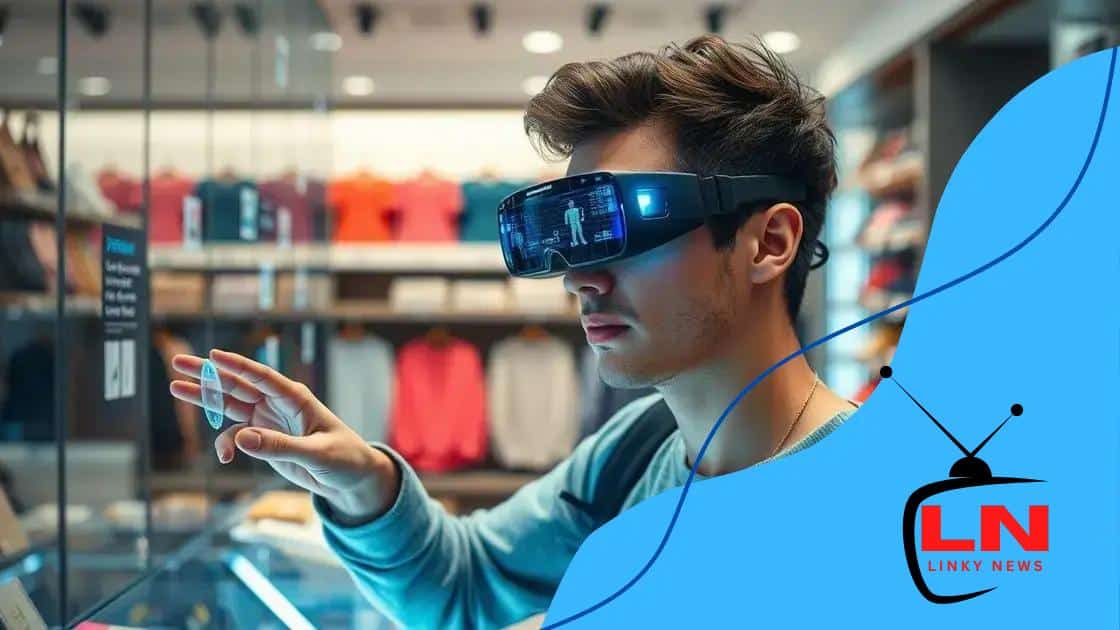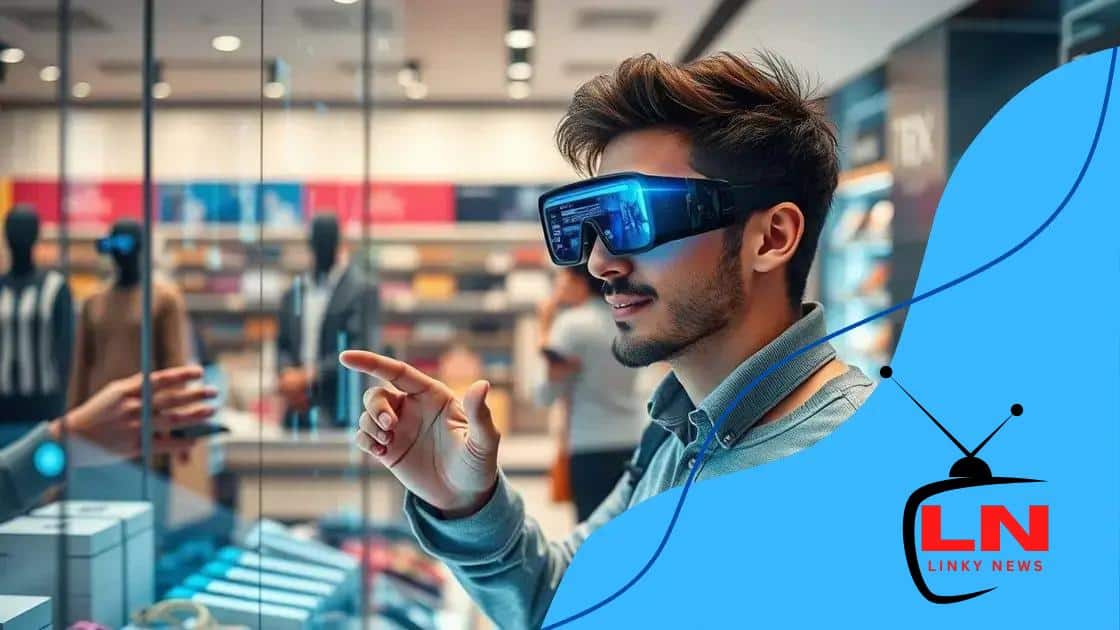Augmented reality in retail: enhancing customer experiences

Augmented reality in retail enhances customer experiences by allowing immersive interactions, personalized recommendations, and improved product visualization, thus increasing engagement and sales potential for brands.
Augmented reality in retail is changing the game for both retailers and consumers. Have you ever imagined trying on clothes virtually or seeing how furniture fits in your living room before buying? This technology offers an exciting glimpse into the future of shopping.
What is augmented reality in retail?
Augmented reality in retail refers to a technology that blends digital content with the real world, creating an interactive shopping experience. This innovative approach allows customers to visualize products in their own environment before making a purchase.
Understanding augmented reality
At its core, augmented reality uses devices such as smartphones and AR glasses to overlay digital information onto real-life objects. This technology enhances the shopping experience by making it more engaging and informative.
Key features of augmented reality in retail
- Interactive product displays: Shoppers can view products in 3D and see how they fit in their space.
- Virtual try-on: Customers can try on clothes or accessories through their screens before buying.
- Enhanced information: AR can provide additional product details and features just by pointing a device at an item.
Augmented reality is becoming a valuable tool for retailers looking to enhance customer engagement. For example, furniture retailers allow customers to place virtual items in their homes, making the selection process easier and more informed.
Additionally, AR creates a fun and immersive shopping experience. Brands are more likely to stand out as consumers explore products in interactive ways. It’s not just about seeing a product; it’s about experiencing it. Customers are empowered by this enhanced visibility and understanding.
As technology continues to evolve, we can expect even more innovative uses of augmented reality in retail. This may include improvements in personalization, creating tailored experiences that cater to individual preferences and tastes.
Benefits of augmented reality for retailers
Benefits of augmented reality for retailers are vast and transformative. This technology is changing how businesses engage with customers and market their products. By leveraging augmented reality, retailers can provide unique experiences that enhance the shopping journey.
Improved customer engagement
One of the primary advantages of augmented reality is its ability to captivate customers. When shoppers can interact with products in a virtual space, they become more involved in the purchase process. This leads to greater interest and higher retention rates.
Enhanced product visualization
With AR, customers can visualize products in their own space before buying. This capability is particularly valuable for items like furniture and home décor. Rather than relying solely on images, shoppers can see how a product fits and complements their existing environment.
- Increased sales: Providing customers a way to visualize products can lead to higher conversion rates.
- Reduced return rates: By enabling customers to make informed decisions, retailers can decrease the number of returns.
- Personalized experiences: AR can tailor the shopping experience, showing products that align with individual preferences.
Augmented reality also facilitates better staff training and product knowledge. Employees can use AR to familiarize themselves with products and their features in an interactive way. This leads to more informed staff who can assist customers effectively.
As retailers adopt AR technologies, they can differentiate themselves in a crowded market. The unique experiences and interactions that AR provides can help businesses create a strong brand identity. Shoppers are more likely to remember a positive experience, encouraging loyalty.
Moreover, AR can attract younger audiences who enjoy technology-rich experiences. Retailers that embrace these innovations may find themselves ahead of their competitors and more appealing to tech-savvy consumers.
How augmented reality enhances customer experience

How augmented reality enhances customer experience is an important aspect of modern retail. The use of augmented reality (AR) allows customers to engage with products in entirely new ways. This leads to a more meaningful connection between the brand and the consumer.
Immersive product interaction
With AR, shoppers can see products in a real-world context. For example, they can visualize how a piece of furniture would look in their home or try on makeup virtually. This kind of immersive interaction helps customers feel more confident in their purchases.
Personalized shopping experiences
Augmented reality can also offer personalized recommendations based on user behavior and preferences. Retailers can analyze customer data to suggest items that fit individual tastes. When shoppers receive targeted suggestions, they are more likely to make a purchase.
- Interactive advertising: AR ads can provide a glimpse into product features that static ads cannot.
- Real-time feedback: Customers can receive instant insights about their selections through AR tools.
- Social sharing: Shoppers can easily share AR experiences with friends, enhancing word-of-mouth marketing.
Incorporating augmented reality into the shopping experience fosters a sense of fun and exploration. This technology encourages customers to spend more time interacting with the brand. As they browse and experiment, enjoyment increases, leading to higher customer satisfaction.
As customers become more accustomed to experiencing products through AR, their expectations rise. They seek out brands that embrace technology to improve service and engagement. Therefore, staying current with innovations like AR is crucial for retailers aiming to remain competitive.
Real-world examples of augmented reality in stores
Real-world examples of augmented reality in stores showcase how retailers effectively use this technology to enhance customer experiences. Many businesses are finding creative ways to integrate AR into their marketing strategies.
Sephora’s Virtual Artist
One notable example is Sephora’s Virtual Artist app. This allows customers to try on makeup virtually using their smartphone cameras. Shoppers can experiment with different looks without the hassle of removing their current makeup. The app also suggests products based on their choices, making the shopping experience both interactive and personalized.
IKEA Place
Another great instance is IKEA Place, an AR app that lets customers visualize how furniture will look in their homes. Users can overlay true-to-scale 3D models of IKEA products in their own space, making it easier to decide on purchases. This not only enhances customer satisfaction but also reduces return rates.
- Target’s AR Shopping Experience: Target uses AR to create unique product displays and interactive experiences in-store, encouraging customers to engage with products dynamically.
- Lowes’ Holoroom: Lowes offers a VR tool known as Holoroom that helps customers design home improvement projects. Customers can walk through their planned renovations before making any decisions.
- Addison Lee: A taxi service that uses AR to show users the best pickup points in their vicinity, improving convenience.
These real-world implementations of augmented reality highlight the limitless potential that this technology offers. Retailers who adopt AR not only improve customer satisfaction but also stand out in a competitive market. As customers continue to seek innovative shopping experiences, the use of AR will likely grow, paving the way for even more exciting applications.
Furthermore, augmented reality can also be a powerful marketing tool. Brands that create memorable AR experiences can enhance their visibility and attract a wider audience. The interactivity and convenience that AR provides can turn casual shoppers into loyal customers.
Future trends in augmented reality for retail
Future trends in augmented reality for retail promise to shape how customers interact with products and brands. As technology advances, retailers are exploring innovative ways to enhance the shopping experience through augmented reality.
Enhanced personalization
In the future, expect augmented reality to offer even more personalized shopping experiences. Retailers will use data-driven insights to tailor AR content to individual preferences. This means shoppers will receive unique recommendations based on their past interactions, making the experience more relevant and engaging.
Integration with AI
Combining AR with artificial intelligence (AI) will take customer interaction to the next level. AI can analyze consumer behavior, predict trends, and optimize the shopping experience. For instance, AR could enable virtual assistants to guide customers through stores, answering questions in real-time and helping them find products faster.
- Seamless omnichannel experiences: Future AR applications will seamlessly connect online and offline shopping, allowing customers to engage with products anytime, anywhere.
- Social shopping: AR will likely play a significant role in social media platforms, enabling users to try products virtually before sharing them with friends.
- Interactive advertising: Marketers may develop AR ads that allow consumers to interact with products in a fun and engaging manner, increasing brand awareness.
Additionally, retailers may implement AR experiences that encourage community engagement. For example, local businesses could host events where customers interact with augmented reality displays and learn more about the products offered. This builds a sense of community while promoting brand loyalty.
As augmented reality continues to evolve, we can expect more innovative uses in the retail space. The potential for AR to revolutionize shopping is vast, making it essential for retailers to stay ahead of these trends. Those who embrace this technology will likely enjoy enhanced customer satisfaction and increased sales.
FAQ – Frequently Asked Questions about Augmented Reality in Retail
How does augmented reality improve customer experience?
Augmented reality allows customers to interact with products in immersive ways, helping them visualize items in their environment before purchase.
What are some examples of augmented reality in stores?
Examples include Sephora’s Virtual Artist for trying on makeup and IKEA Place for visualizing furniture in homes.
How can augmented reality boost sales?
By enhancing product visualization and providing personalized recommendations, AR can lead to higher conversion rates and lower return rates.
What future trends can we expect in augmented reality for retail?
Future trends include more personalized shopping experiences, integration with artificial intelligence, and seamless omnichannel interactions.





